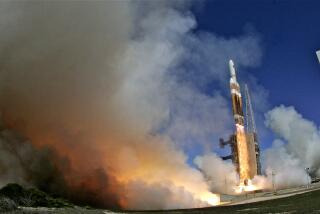Titan Rocket Blows Up at Vandenberg : Secret Spy Satellite Also Believed Destroyed; 58 People Injured
- Share via
VANDENBERG AIR FORCE BASE — A Titan rocket believed to be carrying a secret spy satellite exploded in a huge orange cloud seconds after launch Friday, the second such incident in eight months. Fifty-eight people were treated for skin and eye irritation.
The feared loss of the spy satellite would hamper America’s ability to monitor Soviet activities, with only one other such satellite in orbit, experts said.
A number of fires around the launch site were being battled more than five hours after the explosion, Base Commander Maj. Gen. Jack L. Watkins said.
Air Force officials would not disclose exactly what the cloud was, but schoolchildren were told to stay inside, and about 120 oil workers were evacuated from two drilling platforms in the Santa Barbara Channel. The National Park Service ordered the evacuation of rangers, campers and tourists from the offshore Channel Islands National Park.
Of the 58 people treated at the base hospital, three were admitted, the Air Force said in a statement. Officials would not say if any civilians were treated.
“This will create major problems in the photographic reconnaissance program, in our confidence in monitoring Soviet military activities at a critical time,” said Paul Stares, a military space expert at the Brookings Institution in Washington.
Shook the Ground
The rocket, a Titan 34D, exploded after launch from the Western Space and Missile Center, said Maj. Ken St. John. “Damage was confined to the immediate launch area,” he said.
“A great red-orange puff of smoke came up,” said Victor A. Sanchez, who was working nearby. “It shook the whole ground.”
St. John would not speculate about the booster’s payload. An Air Force statement released in Washington said the payload was classified.
But it was almost certain that the rocket was carrying a refurbished model of the KH-11 photographic reconnaissance satellite or a previously unknown satellite, said Stares and Jeffrey Richelson, a military reconnaissance expert at American University in Washington.
The KH-11 believed aboard was intended to be a test model but was refurbished after another Titan blew up after launch at Vandenberg on Aug. 28, destroying a KH-11 and leaving only one of the satellites in orbit, Richelson and Stares said.
The loss Friday of another KH-11 would put America’s ability to monitor Soviet troop movements, other military activities and compliance with nuclear treaties “in a very precarious position,” Richelson said.
Too Big to Launch
A newer, more sophisticated spy satellite, the KH-12, is too big to be launched on expendable rockets and can be put into orbit only by a space shuttle, Richelson said. The shuttle program was halted in January after the Challenger exploded, killing seven astronauts.
“It would appear that we have at present no means of putting any more photographic reconnaissance satellites into orbit until the shuttle is operating again,” Richelson said, adding that the KH-11 in orbit has 1 1/2 years left in its useful life span.
If it fails before another satellite is launched, “we’ll have no coverage whatsoever,” Richelson said.
The Titan blew up Friday about five seconds after liftoff, said an Air Force official in Washington who spoke on condition he not be identified. About five seconds after the explosion, a self-destruct signal was sent by launch control to make sure that the rocket did not reach anyplace where it could cause damage, he said.
Reliability Testing
Vandenberg, 130 miles northwest of Los Angeles, is where the Air Force tests new missiles, such as the MX, and periodically launches ballistic missiles already in service, such as Titans and the Minuteman III, to test their reliability.
Military and civilian satellites are also launched there.
Vandenberg covers 98,400 acres and is the third-largest U.S. Air Force installation.
All schools in Lompoc Unified School District were told after the explosion Friday to keep students inside, said Supt. James R. Brown. “That’s the safest thing to do for now.”
More to Read
Sign up for Essential California
The most important California stories and recommendations in your inbox every morning.
You may occasionally receive promotional content from the Los Angeles Times.










